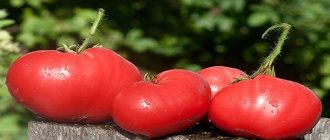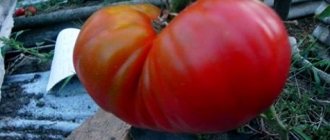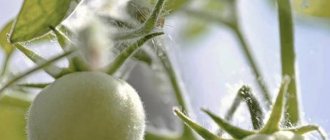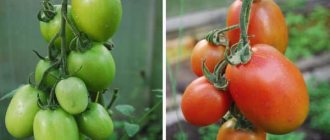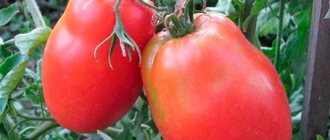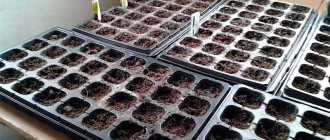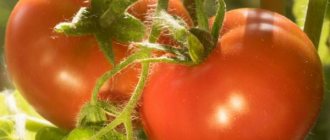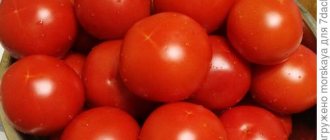Tomato Dobrynya Nikitich is a real hero in the line of large-fruited pink giants. It has no analogues among hybrids. Cultivated in greenhouse conditions and in open beds.
| Height | Landing location | Ripening time | Fruit color | Fruit size | Origin | Fruit shape |
| Tall | Greenhouse, Open ground | Mid-season | Pink | Large | Variety | Flat-round |
Characteristics and description of the variety
The tomato was bred in Russia this century, taking into account the domestic climate and the peculiarities of the culinary preferences of citizens. Breeders sought to develop not only a productive, but also a tasty variety. They succeeded to the fullest - Dobrynya Nikitich tomatoes are distinguished by their rich and bright taste. The slight sourness does not interfere with enjoying the fleshy, dense pulp of the fruit.
The thin skin of tomatoes is practically not noticeable in salads, although it does not allow the fruit to be kept fresh for a long time.
The plant forms a bush that reaches a height of 1.7-2 m. The leaves of a light green color at a young age gradually acquire a rich green color.
The bush's foliage and ability to form stepsons is average. The fruits are formed on the plant in clusters of several pieces. Brushes begin to form after 5-6 sheets. The average weight of tomatoes is from 180 to 300 g, but individual berries can reach a weight of half a kilo.
The color of the peel of the fruit of the Dobrynya Nikitich variety is red. Tomatoes are not characterized by deformation of excessively large tomatoes; they remain flat and round in shape.
In the cross-section photo of the Dobrynya Nikitich tomato, its fleshy structure is visible.
Tomatoes are used for fresh consumption and baking; they prepare lecho, tomato juice, and ketchup. They can be preserved in pieces in jelly and their own juice.
Sowing time
The Dobrynya tomato forms a ready-to-eat crop 115 days after sowing the seeds. Based
Where the crop will be grown (in a greenhouse or open ground) and in what climate zone, a decision is made on the timing of sowing.
The optimal age of seedlings ready for transplanting to a permanent location is 60-65 days.
Depending on the growing region, tomatoes are sown several weeks apart:
- In the middle zone and Moscow region, tomato seedlings are placed in open ground, no earlier than the first ten days of June. Sowing, taking into account the time for seed germination (about a week), is carried out in early - mid-March. Plants can be planted in a greenhouse as early as May, and accordingly, sowing is carried out earlier - in February.
- In regions with a harsh climate (Leningrad region, Siberia, northern Urals), growing Dobrynya Nikitich tomatoes is possible only under cover. Seedlings are brought into greenhouses in May, seeds are sown in February - the first ten days of March.
- In the south of the country, the Dobrynya tomato is successfully grown in the open air, planting seedlings in the garden in May. The crop can be planted in greenhouses in early April. The timing of sowing seeds is from late January to mid-February.
When planting tomato seedlings early, it is necessary to take care of additional lighting, since the length of daylight in January and February is not sufficient for the normal development of the plant.
Secrets of cultivation
To achieve high yields of this variety, you need to correctly distribute all actions from the moment of sowing to harvesting the grown tomatoes.
Sowing
To obtain full-fledged seedlings, you need to sow seeds from March 1 to March 10. The container must be at least 10x10 centimeters. It is necessary to pick seedlings after the appearance of 2 full-fledged leaves. After 65 days, that is, at the beginning of May, the seedlings can be planted in open ground. The distance between them and the rows should be 50x50 centimeters.
It is important! It is during this critical period that young seedlings must be covered with film, because unpredictable May frosts and cold rains and winds can destroy the future harvest. These actions should be continued until stable warm weather arrives.
Planting site and soil
All tomatoes are heat-loving and light-loving plants. The Dobrynya Nikitich tomato is no exception. For this reason, a place for planting seedlings should be chosen with good sunlight and protected from winds.
Growing seedlings
Before you start sowing, you need to prepare suitable soil for the tomato. The culture grows well on fertile, loose soil with a slightly acidic reaction. You can purchase a ready-made substrate for tomatoes in the store or create a soil mixture yourself.
To prepare soil at home you will need:
- 2 parts humus;
- 2 parts garden or turf (forest) soil;
- 1 part peat;
- 1 part coarse river sand or vermiculite.
Before mixing, these components are steamed at 170 degrees for half an hour or poured with a bright pink solution of potassium permanganate to destroy pathogens. Complex mineral fertilizers are added to the finished substrate according to the instructions (Kemira, Raduga, OMU, AVA, Gera).
Seedlings can be grown in individual glasses or common boxes with subsequent picking. Individual containers for Dobrynya tomatoes are selected with a volume of 500 ml, boxes with a height of 8-10 cm.
Any container must have drainage holes to drain excess moisture.
The seeds are sown to a depth of 6-7 mm at a distance of 4-5 cm from each other. To speed up germination, the seed is soaked in warm water with aloe juice (2-3 drops per glass) for 2 hours. The container with the seeds is covered with film and left at a temperature of +22 +25 degrees.
Tomato seedlings must be kept on the lightest windowsill (install lamps if necessary), at a temperature of +22 degrees during the day and +17 at night. This way the seedlings will not stretch.
Caring for the Dobrynya tomato is as follows:
- watering with warm water, without getting moisture on the leaves, 2-3 times a week;
- feeding with a solution of chicken manure (10 g per 1 glass of water) at the age of 2 true leaves;
- picking (transplanting) into separate pots at the age of 3-4 true leaves;
- fertilizing with complex mineral fertilizer 2 weeks after picking.
Before placing seedlings in the garden, the plants are accustomed to bright light and fresh air. The tomatoes are taken outside, first for a couple of hours, gradually increasing the stay time to the whole day.
Features of cultivation and storage
Seeds are sown in light fertile soil. To create it, garden turf, compost, peat, ash, and sand are mixed. Phosphorus-potassium fertilizers are applied.
Plant at a depth of 1.5 cm, a distance of 3 cm. The boxes are covered with film or glass on top.
What are the growing points?
- maintaining a temperature of 22-23 degrees;
- hardening at 14-16 degrees, with a night decrease in temperature;
- irrigation through a spray bottle with settled water;
- picking with 1-2 true leaves.
Ripe tomatoes can be stored for up to 3 weeks in cool, dark rooms.
Planting in the ground and caring for tomatoes
Since Dobrynya Nikitich tomatoes are tall, they are placed in a bed according to a 50 by 50 cm pattern. Trellis are installed along the rows in advance, to which the seedlings will be tied.
Tomatoes should not be planted after potatoes, eggplants and peppers. These plants have common diseases and pests. The crop is placed in the garden after cabbage, legumes, and cucumbers.
Seedlings are planted in cloudy weather or in the evening. It is recommended to bury the lower part of the stem into the soil up to the first leaves. Roots form on the buried part of the stem, which will help feed the plant.
The soil under the tomatoes is mulched with straw, tree bark, and grass clippings to retain moisture.
Dobrynya tomatoes are formed into 1-2 stems. Stepchildren are removed at least once every 10 days, pinching off the shoots until they reach 5 cm. When the first bunch of fruits is formed, all the leaves under the cluster are removed.
Tomatoes are given moderate but plentiful watering - 5-10 liters per bush. The plant especially needs moisture during the flowering and fruiting period. The water should not be cold.
During the ripening period of tomatoes, watering is reduced to once a week.
15 days after planting the seedlings in the garden, the tomatoes begin to be fed. Alternate organic (infusion of grass, manure, grain fertilizer) and mineral fertilizers (superphosphate, potassium sulfate, ready-made mixtures). Nutrient solutions are applied at the root every 15-20 days.
Secrets of cultivation
The plant is tall, so Dobrynya Nikitich tomatoes are planted using the 50 x 50 cm technology. The growing season is 110-115 days.
If the housewife has grown good, strong seedlings, then at the age of 50 days they can be planted in a greenhouse.
To obtain a good harvest, the stem is formed into 1-2 trunks. If you want to get larger fruits, after 6-7 ovaries the stem is pinched.
Anyone who has planted indeterminate tomatoes in a greenhouse knows how important it is to remove the plant’s lower leaves and shoots in time to improve fruit set and accelerate ripening.
Also, an important condition for obtaining a rich harvest is proper fertilization of tomatoes and watering regime. For fertilization, the following activities are carried out:
- Mulching the soil. It can be carried out continuously, starting from the moment the seedlings are planted in the garden. It is better when the mulch is small, then as it dries it is convenient to loosen the soil with it, and it will continue its further beneficial effect in the soil.
- Mineral fertilizing should be carried out at least three times during the entire growing period of the plant.
- The application of organic fertilizers can be done alternating with or while watering the tomato throughout the entire growing period, from planting the seedlings until the last harvest.
The most important thing when fertilizing a tomato is not to over-fertilize, otherwise the bush will die!
Diseases and pests
The Dobrynya Nikitich variety is resistant to the most common tomato diseases: late blight, bacteriosis, subject to proper agricultural technology. But with a lack of calcium in the soil and lack of watering, it can be affected by blossom end rot. Dry black spots appear on the tip of the tomatoes. The plant is treated with fertilizers containing calcium (wood ash, eggshell infusion, calcium nitrate) and increased watering.
In a greenhouse, tomatoes can be bothered by aphids. They get rid of the pest by washing the shoots with soapy water, tobacco or garlic infusion. Before the plant blooms, you can use Inta Vir.
In open ground, tomatoes are attacked by the Colorado potato beetle, especially if there is a potato plot nearby. The pest is collected manually or the plants are treated (before flowering) with Corado.
Advantages and disadvantages of the variety
Analyzing reviews from gardeners about the Dobrynya Nikitich variety, its strengths were identified:
- high productivity;
- pronounced taste and aroma of fruits;
- disease resistance;
- meaty consistency.
Disadvantages in the description of the variety include the thin skin of tomatoes, which is why they cannot be stored and transported. This drawback does not allow the Dobrynya variety to be grown on large farms.

